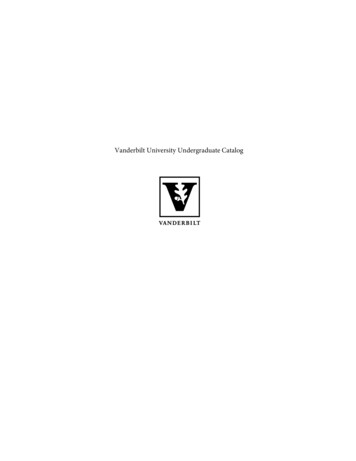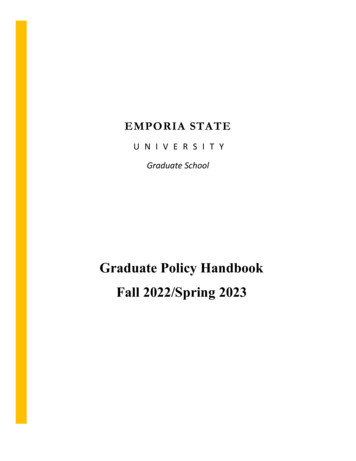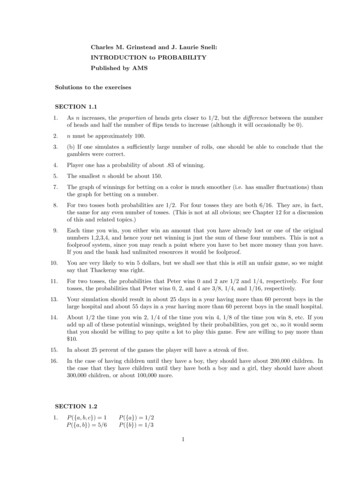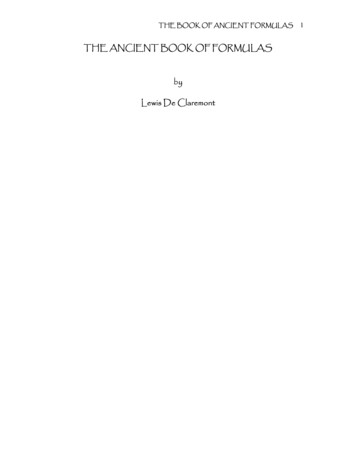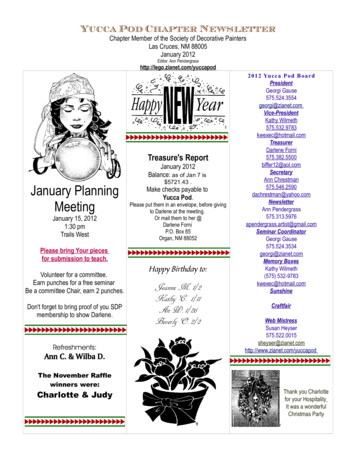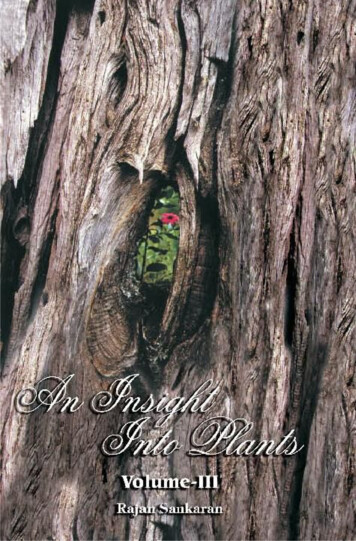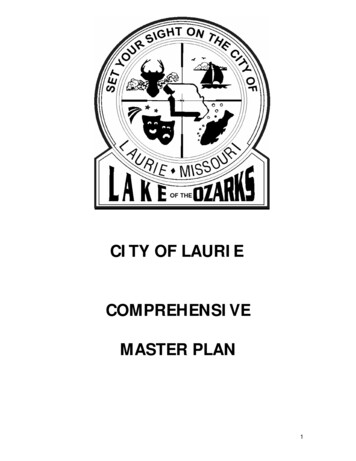
Transcription
CITY OF LAURIECOMPREHENSIVEMASTER PLAN1
INDEXIndex1Governing Body/Planning and Zoning Commission3Purpose4Mission Statement4Community Profile5Population Characteristics6Economic Characteristics7Future Growth Potential7Land Use DevelopmentExisting Land Use89Land Use Plan11Housing Characteristics12Housing Density13Housing Strategy14Streets and Circulation15Major Streets16Collector Streets17Community Facilities182
Parks18Schools20Public Buildings21Post Office21Fire and Ambulance Service22Seniors Center22Water System22Water Production23Water Storage24Water Distribution System25Water System Improvement Plan26Sanitary System28Municipal Treatment Facilities28Sanitary Sewer Collection System28Sanitary System Improvement Plan29Downtown Area30Goals and Objectives31Appendix A – Population and Economic Characteristics and Future GrowthPotential33* Appendix B – Existing Land Use and Street Map of City37* Appendix C – General Proposed Land Use Map38* Morgan County Recorder of Deeds OfficeCabinet NumberSlide Number3
* Camden County Recorder of Deeds OfficeCabinet NumberSlide NumberCITY OF LAURIE, MISSOURICOMPREHENSIVE MASTER PLAN724 N. Main, P. O. Box 1515Laurie, Missouri 65038GOVERNING BODYRichard Purdon, MayorBoard of Aldermen:Chuck ChorpeningRod HayesMartha MoulderMargaret TellmanPLANNING AND ZONING COMMISSIONJames Clarke, ChairmanChuck ChorpeningDavid ChristiansenBrent DunnawayJames GerkePaul IrwinRichard PurdonCONSULTANTSStephen Jeanetta, University of Missouri Outreach and Extension ServiceRon Higginbotham, University of Missouri Outreach and Extension ServiceDr. Judith Stallmann, University of Missouri Outreach and Extension ServiceMary Anne Patten, University of Missouri Outreach and Extension Service4
PURPOSEThe purpose of this comprehensive master plan is to show the planning andzoning commission’s recommendations for the physical development and uses of land inthe City of Laurie. It includes, among other things, the general location, character andextent of streets and other public grounds, places and spaces and the general locationand extent of public utilities, businesses and residential areas. The plan explains thehistory of the community, its demographics and economic picture. The plan establishesgoals and objectives for the next 20 years.The plan is not a regulatory ordinance, but it is a guide to be used when regulatoryordinances are developed and enacted.It is not a detailed capital improvementprogram showing exact locations of public improvements and community facilities. Theplan is a comprehensive document in that it covers all portions of the city and allfacilities that relate to development.MISSION STATEMENTThe mission of the City of Laurie is to provide an inviting, family oriented,comfortable and safe community for its residents and neighbors to work, play and live inas well as to enjoy the relaxed atmosphere of rural living with all the necessary anddesirable amenities to accomplish this goal. This mission is to be achieved through the5
dedicated efforts of the mayor, board of aldermen, planning and zoning commission andcity employees focused on the welfare and best interests of all the residents andbusinesses of the City and through orderly planning and accommodation of reasonablegrowth and development.COMMUNITY PROFILEThe City of Laurie is a community near but not on beautiful Lake of the Ozarks incentral Missouri located mostly at the southern end of Morgan County with a smallamount of land in Camden County. Laurie is situated on the West side of the lakemidway between Versailles (population 2,565) 17 miles to the North and Camdenton(population 2,779) 20 miles to the South. Gravois Mills (population 208) is 8 miles tothe North and Sunrise Beach (population 368) is 3 miles to the South.Laurie andSunrise Beach are both experiencing significant development at a proportionally greaterrate than the rest of the area.While the City has a permanent year round population, the activity swells duringthe summer months when thousands of seasonal residents and tourists visit the area.The physical features have played a part in the development of the area with its rollinghills and heavily forested areas.The city evolved from a few stores on Highway 5geared to the tourist season to a growing and vibrant community with many retirees.Laurie was incorporated in 1966 with a population of 161. However, active localgovernment began only in 1984. Laurie has annexed over 80 percent of its 3800 acressince 1987 and most of this is undeveloped. Today the community is in the midst of agrowth surge in residential and commercial development.6
In April, 2003 the voters decided to move from being a village form ofgovernment to becoming a fourth class city.This is just another indication of theforward thinking nature of the community. Also in April, 2003 the Missouri Departmentof Economic Development named Laurie an “All Missouri Certified City” based on thereport submitted at the completion of the comprehensive community assessment.Laurie is a combination of the place with its physical setting and communitydevelopment and its most important resources – its people.This community profile section examines the population and economiccharacteristics and future growth of Laurie.Population CharacteristicsThe census population of Laurie in 1980 was 169, in 1990 it was 507 and in 2000it was 663, an increase of 156 (30.8 percent) from 1990. A count conducted in June,2003 for the establishment of city wards revealed the population had grown to 748reflecting a 13 percent increase in less than three years. In Morgan county the numberswere 13,807, 15,574 and 19,309 (24 percent increase) respectively. The City andadjoining counties and communities have experienced increases in population during thepast 30 years in greater proportion than Missouri and the nation have experienced. Forinstance, Missouri’s population increased by 9.3 percent from 1990 to 2000 and theUnited States by 13.2 percent. The tourism draw of the lake and the expansion of otherrecreational activities, such as golf courses and shopping malls, have contributed to thisgrowth.The City is showing a steady increase in population primarily with retireesmoving into the community and long time residents moving off the lake.There is7
definitely an age disparity between Laurie, Morgan County and Missouri. In Laurie in2000 only 18 percent of the population was under 18 years of age whereas 42.5 percentwas over 62. In Morgan County 23.1 percent were under 18 years of age and 25.7percent were over 62, in Camden County 20.2 percent were under 18 years of age and23.6 percent were over 62 and in Missouri 25.5 percent were under 18 years of age andonly 15.9 percent were over 62. Thus by percentage of residents, Laurie has almostthree times as many residents over the age of 62 as does Missouri. Twenty-six percentof Laurie’s residents are over 75 (13.2 percent over 85); 6.4 percent of Missouri’sresidents are over 75 (1.7 percent are over 85).Economic CharacteristicsEmployment in 2000 (253) rose 58 employees from 1990 (195). Although thetotal work force is relatively small, this 29.7% increase in employment primarily is theresult of expansion of job opportunities in health care and social assistance;management, professional and related occupations; service occupations, sales and officeoccupations; and production, transportation and material moving occupations. In 2002there were 148 licensed businesses in Laurie which means many in the work force liveoutside the corporate limits.A combination of many tourists in the summer and adisproportionately large retiree population produces the need for many jobs in theservice occupations.According to the 2000 census information, approximately only 6 percent ofLaurie’s employed persons work in manufacturing. Nearly 55 percent work in service,sales and office occupations. Although Laurie is a rural area, no one is employed infarming as of 2000.Future Growth Potential8
Laurie’s future population growth will depend on the extent of the success incontinuing to build economic vitality in the community. The economic future is partiallydependent on creating basic jobs, ones that provide year round employment andstability to balance the present heavily dependent seasonal employment.This isespecially true for employment outside of Laurie on the lake with many jobs related toresorts, marinas, restaurants, boat sales and recreational activities.A logical area to strive to create permanent jobs and attract younger residents isin new manufacturing and commercial businesses. Between 1990 and 2000 the numberof residents in manufacturing jobs increased from 7 to 15. However, this representsonly 6 percent of the work force.The creation of additional basic jobs will have a direct impact on the population.More stable jobs providing a decent income will generate more housing needs andsupport services which can generate more people moving into the area. An anticipatedinflux of baby boomers to the lake area will create a need for more service occupationjobs as well.LAND USE DEVELOPMENTFor most of Laurie’s brief history as an incorporated area, the land use patternwas very predictable. Commercial uses were centered along Highway 5 for about a milein both directions from the intersection with State Road O. Single family housing and afew apartments were interspersed near the highway and along several of the lake roadsnear the highway.The remainder of Laurie was primarily undeveloped.(Map atAppendix B).9
In the mid-1990s one planned subdivision (Ozark Meadows) was started near thenorthern boundary line of Laurie and a second one (Indian Rock Estates) took off on thenewly annexed golf course on the eastern end of the city. Population growth in Lauriehas been steady but primarily through annexation with the exception of the recentresidential development on and near the golf course.Residents rely almost exclusively on the automobile for transportation instead ofpublic transportation or walking.There is limited use of OATS (Ozark AreaTransportation System) by senior citizens which has recently seen significant reductionsin service. The spread out nature of the community and the lack of sidewalks and biketrails impede getting around by walking or biking.Existing Land UseBusinesses initially developed along Highway 5 to support the growing tourismbusiness as the Lake of the Ozarks grew in popularity. This spawned the developmentof retail sales outlets, the lumber yard, banks, a mall, churches, real estate offices, carand boat sales, grocery stores, restaurants, etc. Residential growth occurred aroundthis core area, although many of the business owners and employees live outside of theCity. More recently residential growth has occurred in the area of the golf course onthe eastern end of town with over 50 single family units completed and several underconstruction, one duplex completed and one under construction and two four unitvillas. Most of this construction has taken place in the past five years. Five single unitswere constructed in 2002 across the street from the golf course.One subdivision began development off of State Road RA a couple of years agoand has two residences completed. Two subdivisions began development in 2003 on10
Chelsie Road (Lake Road 5-27) at the western end of the city. One residence has beencompleted in one of the subdivisions, and one is under construction in the other.There is only minimal industrial development in Laurie with three widelydispersed facilities. Total resident employment at these businesses is 15. The mostrecent examples of multi-use commercial developments are Corporate Woods onHighway 5 and Lake Wood Development on State Road O. Corporate Woods presentlyhas a bank, doctors offices/rehabilitation center/health mart, a liquor and tobacco store,a paint store and a fast food outlet. An auto lube facility is under construction. Severallots remain available. Lake Wood Development on O Road has a five-theater cinema, alaundramat, a pizza parlor and steak house, an ATM and several spaces available forrent. Two more buildings for retail stores are planned for the future. Other notableexamples of recent commercial land uses include a new grocery store and fast foodoutlet across the highway from Corporate Woods on Highway 5, a fine dining restaurantat the golf course and a 15 unit independent living apartment facility on State Road RA.A development to include several retail stores is under construction on Highway 5 nearthe city limits on the southeast end of the city.The older portions of the business district have experienced recent upgrades.Either through occupant changes or owners updating their facilities, more than 20businesses have remodeled or enlarged their businesses in the past couple of years.However, there are several operating businesses and closed stores on Highway5 and State Road O that need rehabilitation or demolition. These aesthetic eyesorespresent a challenge for the city.Community facilities are located on or near Main Street (Highway 5). City hall isnear the north end of town and houses the clerk’s office, police station, department of11
public works and water patrol. The 28 acre ball park, playground and picnic area is onState Road RA a short distance from Highway 5; and the 24 acre Laurie fair grounds isjust off of Highway 5 in the heart of Laurie. The maintenance facility for the departmentof public works is on the fairgrounds. The Gravois Fire Protection District fire station inLaurie and District 5 Headquarters is on State Road O two blocks from Highway 5. Thecommunity center is a little further south on Highway 5.There are no rail terminals or rail lines in Laurie, and there is no airport in theCity. No such facilities are contemplated during the planning period.Land Use PlanThe land use plan builds upon the existing land use pattern by recommendingareas of growth and development.(Map at appendix C).The community shouldcontinue to develop the large areas of undeveloped land within the existing boundariesof the city and carefully consider future areas of expansion.Residential growth should be encouraged in areas to the east of Highway 5 inthe areas where there is practically no development of any kind. With the constructionof a city-wide central sewer system, several new subdivisions and new businesses areanticipated.Commercial land uses should be concentrated on Highway 5 and State Roads135 and O where there is land available for development. However, with or withoutadditional development on Highway 5, the state needs to widen Highway 5 with a thirdlane south of the intersection with State Road O by putting in a turn lane.The now defunct 15 year Missouri transportation plan identified a new route forHighway 5 through Laurie that would have been east of its present location.Thatappears to be out of the picture for the foreseeable future. However, either a similar12
plan or the improvement of existing Highway 5 from Gravois Mills to the Niangua bridge(approximately 15 miles) must be vigorously pursued. This plus present and plannedconstruction would provide about 35 miles of a super two highway from Versailles toCamdenton on Highway 5.The land use plan proposes the identification of one or more sites for anindustrial site(s) or business park. This would provide for more stability in the labormarket with year round employment and better wages. The City should demand anaesthetically-pleasing site plan for any industrial/business proposal as well ascoordinated access roads.A considerable amount of development has taken place outside the city limits,especially along Highway 5 to the southeast between Laurie and Sunrise Beach. Morelimited commercial and residential development exists along Highway 5 to the north,along State Road O to the northeast, and State Road 135 to the northwest.Annexation to the boundary with Sunrise Beach was initiated several years ago.The City also explored a merger with Sunrise Beach. These efforts were dropped whenit became apparent that the annexation would be involuntary, and the composition ofthe board of trustees changed.Since there is substantial land within the City that has not been developed, thereis no urgency to annex if the only reason is to obtain land for development. However, itmay be appropriate to consider annexation of undeveloped areas to avoid uncontrolledand undesirable growth patterns or more complicated annexation efforts in the future.Renewed exploration of the feasibility and desirability of a merger with Sunrise Beach iswarranted.13
Areas outside of the corporate limits of Laurie are important to the City becauseof regional economic development potential. These sites have the potential to provideemployment within a reasonable driving distance of the City.Housing CharacteristicsLaurie has a mixed stock of housing with a total of 321 housing units accordingto the 2000 census. Only 2 housing units were built before 1940, and only 8 units areolder than 50 years. On the other hand, 80 units are less than 5 years old as of 2000,and the average age of all units was 16.7 years at that time. More than 35 new housingunits have been built since 2000, primarily on or near the golf course.Average Age of All Housing UnitsLaurieMorgan CountyCamden 27.020.435.034.2Construction of new housing is only part of the housing picture in Laurie.Maintenance of older housing units is an economic and desirable way to properly houseresidents. As summarized above, there are very few old housing units in Laurie. Thesehouses are widely scattered and with a couple of exceptions are in respectablecondition. Six of eight units built before 1940 were removed in the 1990s.The percentage of owner occupied housing stood at 63.5 percent in 2000, upsubstantially from 48.8 percent in 1990. However, this is still considerably less than82.9 percent of owner occupied units for Morgan County and somewhat less than the14
70.3 percent for Missouri. Renter-occupied units in Laurie declined from 51.2 percent to36.5 percent.Housing density (the number of persons per household) declined in Missouri inthe 1990s. Contrary to 1990, Laurie had a lower housing density in 2000 than the stateand was at 1.98. (See Table 1.)Table 1Housing DensityCity of Laurie, MissouriLaurieMorgan CountyCamden CountyMissouriU. The City has limited public housing which consists primarily of two apartmentcomplexes on State Road O, one with 24 units and the other with 20 units. No otherknown projects are in development.Housing StrategyThe housing strategy in Laurie should be twofold: (1) construct new housingunits to provide for growth to meet the needs for different types of housing; and (2)maintain and rehabilitate older housing stock.To meet population growth and provide adequate housing quality, Laurierequires around ten new housing units annually based on current growth. During thenext 20 years, 250 housing units should be constructed. Since most of the housingstock is relatively new, very few units, if any, will require demolition. Based on the15
growth rate over the past 20 years, Laurie’s population could almost double in the next20 years.In the recent past, few multi-family housing units have been constructed despitea lack of zoning and the availability of large tracts of developable land. The land useplan encourages new residential units be multifamily (condominiums and rental) as wellas single family. Proper development of a collector street system will alleviate the trafficcongestion problem which sometimes affects poorly sited multi-family developments.These units should be popular with singles, young couples, small families and oldercouples. Desirable locations for multi-family housing include the east side of Highway 5and down State Road O. The majority of new housing would still be single-family units.A portion of the single-family market will be met by modular housing.Maintenance of existing stock is an important premise of the housing strategy.With the average unit in Laurie being only 16.7 years old, maintenance should be less ofa problem than in other communities.However, the above average age of thepopulation may present challenges when it comes to routine maintenance of housingunits. The average age of units in Morgan County is 27 and in Missouri is 35.The City exhibits an interesting dichotomy. The age of the population is wellabove the averages for both the county and the state, but the commercial developmentand residential areas are much younger than the averages for the county and state.STREETS AND CIRCULATIONLaurie’s hilly and wooded terrain has been both an attraction and an obstacle tothe development of the area and for an adequate street and circulation system. Theprimary artery is Highway 5 (Main Street) which runs predominantly north to southeast16
through the city. State Road O meets Highway 5 at a T intersection in about the middleof town. State Road O and Bass Point Road (Lake Road 5-30) are the only roads in aneasterly direction through town from Highway 5. Only about three quarters of a mile ofBass Point Road is in the City.On the west side of Highway 5, there are five principal roads from west to east:State Road 135, Lake Trail Road (Lake Road 5-24), State Road RA, Chelsie Road (LakeRoad 5-27), and Purvis Road (Lake Road 5-29). The remainder of the streets in the Cityare primarily short roads into residential areas; several are dead ends. Streets werebuilt on an as needed basis with no overall plan with the exception of Ozark Meadowsand Indian Rock Estates.Highway 5 and State Road O accommodate the majority of the local trafficvolume. Major streets should be designed for crosstown and regional traffic. In futuredevelopment collector streets should be designed to direct most local traffic to the majorstreets, and thereby free the residential areas of through traffic.Major StreetsMain Street (Highway 5) is the primary regional highway through Laurie in thenorth-south direction. Highway 5 is heavily traveled, narrow and hilly outside of Laurie.It has three lanes for about a half mile through part of Laurie but only two lanes most ofthe way. Inadequate shoulders on much of Highway 5 pose a danger to safety. MakingHighway 5 three lanes through the city limits of Laurie should be a near-term goal. Thelong-term goal should be to make the highway from Gravois Mills to Camdenton at leasta super two lane highway.State Road 135 proceeds in a north-westerly direction from Highway 5. StateRoad 135 is two-lane with asphalt surface in good condition; but the road is narrow,17
curvy and hilly with minimal shoulders. State Road RA proceeds in a westerly directionfrom Highway 5. This road surface is in good condition with ample shoulders. StateRoad O proceeds northeasterly from Highway 5 with two lanes of asphalt surface whichis in deteriorating condition and is curvy with minimal shoulders.Arterial roads also serve as part of Laurie’s major street system. Lake Trail Road(Lake Road 5-24), Chelsie Road (Lake Road 5-27), and Purvis Road (Lake Road 5-29)connect west and southwest portions of the City with Highway 5, the central businessdistrict. State Road O and Bass Point Road (Lake Roads 5-30) connect the northeastand southeast portions of the City to Highway 5. Although these roads can adequatelyhandle the volume of traffic, Lake Trail Road and Bass Point Road are gravel. PurvisRoad was recently resurfaced and reconfigured so that the intersection with Highway 5is perpendicular. The plan is to asphalt surface all the gravel roads the City maintainsafter the completion of the central sewer project. The sewer project is scheduled to becompleted in March, 2004.Planning is underway for financing the road surfacingproject.Corporate Woods and Ozark Meadows are in the process of tendering theirasphalt roads to the City for maintenance. Owners of several gravel roads are in theprocess of tendering their roads to the City in accordance with an ordinance revised inearly 2002. When these actions are completed, the city maintained streets will roughlydouble in size from the present five miles.Collector StreetsThe existing system of collector streets and requirements for future collectorstreets varies by the geographic location in the City. The central and west/southwest,east and southeast portions of Laurie will each be addressed.18
The central and west portions of the City contain the business district, severalresidential neighborhoods and some scattered housing. Collector streets include LaurieHeights Drive, Mooreview Drive and Faith Boulevard.The east portion of the City to Highway 5 is served by Brook Valley Lane,Dobbins Drive and Silvey Road.The southeast portion of the City to Highway 5 isserved by Dogwood Lane, Blue Bird Lane, Dunwurkin Road, Southport Boulevard andSherman Ridge.The east portion of the City on to State Road O is served by Hibdon Drive, Elk’sRoad, Firehouse Lane, Oak Street, Ridge Street, Myra Drive, Rocking H Lane, MetcalfCourt, Markum Road, Carefree Lane, Flagstone Road, Osage Village Road, EagleAvenue, Indian Lake Avenue, Apache Drive and Indian Rock Avenue.Plans for any future subdivisions should be required to include collector streets toachieve maximum efficiency and integration into the existing arterial roads.COMMUNITY FACILITIESCommunity facilities, such as parks, schools, public buildings, seniors’ activitycenters, sanitary systems and water systems, are a special part of the community. Theyhave a very definite influence on the community’s appearance and livability, as well asproviding essential health, safety, educational, recreational and other public services.Following are the analyses and plans for existing and proposed community facilities.ParksParks are an important element of any city. Recreation facilities such as ballfields, playgrounds and exercise courses provide active outdoor recreation for a public19
with an increasing interest in utilizing leisure time. Passive park facilities, such as picnicareas and woods, provide a peaceful sanctuary and visual break from everyday routine.Numerous standards of varying types have been developed for recreationfacilities and parks. The national standard is 2 acres per 100 persons—one acre in largeparks and one acre in neighborhood and community parks. Laurie’s approximately 52acres of parks far exceeds the national standard with 12.75 acres per 100 persons.However, both parks are central parks with no neighborhood parks in the City.The City owns two recreation facilities. Quasi-public and private organizationsoperate additional facilities.The nearby Lake of the Ozarks, of course, is a majorrecreational area with over 1,100 miles of shoreline. Community wide facilities includethe 28 acre ball park and picnic area and the 24 acre Laurie fair grounds with aplayground, soccer field, walking trail, picnic pavilions, sanctioned horseshoe pits, stageand fairground facilities. The Rotary Club operates the only indoor swimming pool in thearea.Recent fairground park improvements in 2002 and 2003 include adding twopavilions, constructing more restroom facilities, installing additional playgroundequipment, removing dead trees from both parks, reconfiguring part of a road toimprove drainage, adding more horse shoe pits, repairing the stage and making majorupgrades to the electrical system.The outfield fence and some of the playground equipment at the ball park werereplaced in 2003.Fairground improvements in progress or being planned include making additionalelectrical upgrades, building a gazebo, acquiring more playground equipment andputting asphalt on the roadway used for vendors and displays at the fairgrounds.20
The Board has approved funding for improvement of the backstop at the ballpark. Replacement of the scoreboard in under consideration. The restroom facilities atthe ball park need to be modernized which is contemplated when the central sewersystem is installed.There are no neighborhood parks or play fields in Laurie. This is due in part tothe lack of any plan as previous development occurred, the central location of the ballfield and the fairgrounds, the minimal number of residential neighborhoods and thedispersed nature of the residential units. A requirement to dedicate a portion of thearea for a neighborhood park should be included in regulations for subdivisiondevelopment.SchoolsEducation of our children has long been recognized as an essential investment inthe future. In today’s world educational facilities and programs touch the lives of allresidents.Laurie is served by three school districts: the Morgan County R-II District, theStover School District and the Camdenton R-III District.In addition, the Lake WestChristian Academy (K-12) in Sunrise Beach serves the planning area.The Morgan County R-II District has a PK-3 elementary school, a PK-5elementary school, a 6-8 middle school and a 9-12 high school. The Camdenton R-IIIDistrict has two elementary attendance centers (K-5) and K-3, 4-6 and 6-12 centers.Both school districts have each had two unsuccessful bond issues in recentelections. Both are re-evaluating their needs and plans for future bond issues. Whilethere is widespread recognition of the need for improvements, there is substantialdisagreement as to what these improvements should be.21
In 2000 Laurie had 80 children enrolled in grades K-12, an increase of 25students from 1990. Thirteen were enrolled in college in 2000 compared with 5 in 1990.These low numbers are not surprising considering the age distribution of the populationin Laurie which is skewed to the older age groups.Although there has been interest expressed by some to build a school in Laurie,this is deemed not to be feasible for the foreseeable future.The small studentpopulation, financial obstacles and
Laurie was incorporated in 1966 with a population of 161. However, active local government began only in 1984. Laurie has annexed over 80 percent of its 3800 acres since 1987 and most of this is undeveloped. Today the community is in the midst of a growth surge in residential and commercial development.



